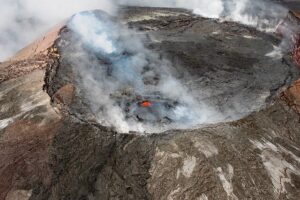
When I hear the words “volcano” and “eruption” in the same sentence, my mind immediately jumps to images of Pompeii or any number of disaster movies where people are running away from lava flows. So you can imagine my surprise when I woke up on a seemingly quiet Monday morning to the news that Kilauea had once again begun erupting. News headlines everywhere said things like “Hawaii’s Big Island on Red Alert.” So I rushed to my window, only to find the sky was still blue, people were calm and, in general, nothing was different.
Sensational headlines like that are great for drawing in readers but, in truth, most of Hawaii’s residents were carrying on as if nothing was happening. The impact of such an event varies greatly depending on a wide number of factors. Out here in Kona, the distance to Kilauea is simply too great to feel or even hear the excitement happening at the caldera (volcanic crater). All of the lava flow events thus far this time have remained contained in the crater and, at present, no homes were threatened and no people were displaced. As well, vog (smog containing volcanic residue and gases) levels have stayed relatively low across much of the island.
This being said, volcanic activity is never something to be taken lightly and no two volcanic eruptions are the same. It requires proper insight to know exactly how impactful it is and will become. Many great resources exist to help you understand the effects of the volcano and its current conditions. Two sources that I’ve found most informative were the YouTube channel “Big Island Video News” and air.doh.hawaii.gov, a government website reporting on the air quality in Hawaii. With proper information you can more easily gain perspective and know exactly how Kilauea effects you or an area you might be interested in visiting. In the immortal words of Douglas Adams and the Hitchhiker’s Guide to the Galaxy “Don’t Panic.”
Nick Wolf
Media & Technology Administrator